Gold Rush ( https://jtippetts.github.io/GoldRushFrame.html ) is a game about converting Heat, generated by special heat-producing units, to Gold. To do so, it makes use of various other units to handle the conversion. The point of the game is to maximize the amount of Gold produced, in order to fund even further upgrades. In the game, there are numerous quantities that move or flow from one location to another. Most of this flow is handled by various pipes. These pipes can be constructed at-will, and automatically connect to units enabled to connect to that kind of pipe.
Conduit
The first type of flow control + pipe that the player will encounter is Command Signal, conducted by a type of pipe called Conduit. Command Signal is a quantity generated by a unit called a Command Center, and it has the quality of doubling (or more, as the bonus is scalable) the effectiveness of a connected unit. Command Signal flow is simple, in that it is a simple 1 or 0 quantity that flows by shortest-path to any unit that is connected to a Command Center, either by Conduit or by proximity:
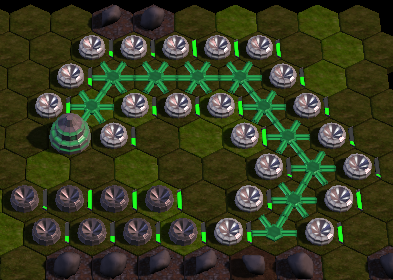
All units connected to the Conduit are buffed (shown by the white color in this image), while units not connected do not gain the bonus and are dark. The connected components function at double capacity, so a part of the logistic strategy of this type of flow is to maximize the connectedness of units, and use tile space efficiently. A well-optimized layout can be more effective than just space-filling with the un-buffed units. In this image are a number of PannerBots: self-contained, non-heat-using units that generate a tiny amount of Gold over a duration just by existing. They're the starting unit of the game, and scale poorly over time, so connecting them with Conduit early can be a big help. Each map only allows a single Command Center, so layout is key.
Heat
The next type of flow control the player will encounter is Heat Pipes. Due to game rules such as a prohibition on building Heat Sources on grassland (environmental regulations, you know) it is often desirable or necessary to generate heat in one location and transport it to another. For example, the Savannah map is a large grassland area with only a small number of dirt tiles where heat can be built, so using Heat Pipes to transport heat is beneficial:
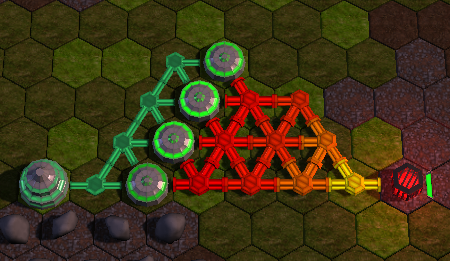
In this image, I have a Charcoal Furnace on the right (a low-level heat source) built on a patch of dirt. Heat pipes conduct the heat produced by the furnace to the Camps on the left (green units connected to Conduit for double effectiveness) which will convert the Heat energy to Gold. This flow system is modeled on shallow-water pipe equations to simulate heat flowing through the system. Units that handle Heat have a rating (upgradeable) for how much overheat they can hold before being destroyed. The overheat held by the pipes is indicated by the color of the unit. Heat Pipes range from dark reddish to white as they approach their heat threshold. Similarly, heat-using units will also show their overheat by color:
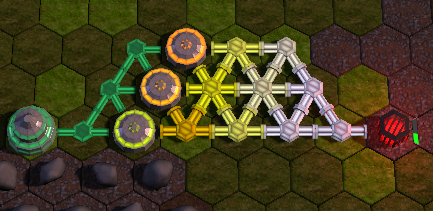
In this image, one of the Camps was removed, resulting in an unstable system where more heat is generated than the connected Camps can convert, so the excess is accumulated as overheat. You can see that the camps are turning from green to orange. The Camps are colored from dark to green based on the percentage of their conversion capacity they are handling, then from green to red based on how much overheat they are holding. When a unit overheats beyond its capacity, it is destroyed. The Heat is transferred smoothly through the pipe system using a simple flow method approximated from water simulations. In the first image of heat pipes, the system is stable: the Camps are converting all heat produced by the furnace to Gold. The overheat present is simply that which is accumulated as the system reaches equilibrium; units nearer a heat source in a system will naturally hold more (though non-increasing) amounts of overheat.
Heat Sending
An upgrade to the Heat pipe system is the addition of Heat Sending units. These are a means to magically teleport heat from Senders to Receivers:
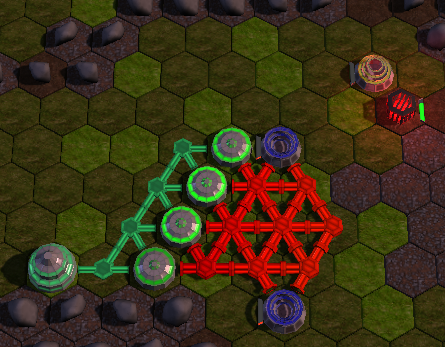
In this image, heat from a Charcoal Furnace is collected by a Heat Sender (yellow unit) and divided equally among all Heat Receivers (2 blue units connected to heat pipes). A Sender can collect heat from any heat-holding unit directly, but a Receiver can only discharge Heat into a Heat Pipe, and not into a Camp or other consumer directly. Wise use of Senders and Receivers makes it easier to avoid excessive overheating, by allowing you to disperse the Heat more evenly through a connected network, and also allow you to make better use of difficult maps such as Savannah, which have lots of grassland limiting where Heat sources can be built. The flow is handled by summing the total amount of heat held by all Senders and equally dividing it among all Receivers.
Water
The next type of flow encountered in the game is Water, which flows by the same conduction rules as Heat through Heat pipes, However, Water will simply fill a system to capacity, then stop filling once capacity is reached, rather than overfilling and destroying components. There are Camps which use Water to more efficiently convert Heat to Gold, the Water allowing them to handle more Heat than normal.
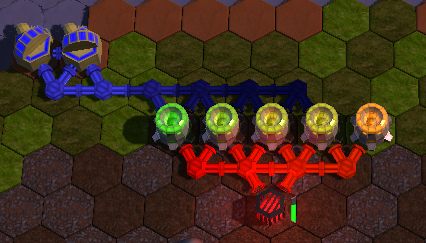
In this image, water is being supplied to the leftmost 4 Camps, while the one on the right has no water supply. The system is stable: heat in the system is not accumulating, and all heat is being converted, but you can see that the rightmost unit is holding a significant amount of overheat due to not having Water. Additionally, you can see that the Water-cooled units further along the pipe system are holding more overheat than the leftmost unit, due to being partially Water-starved. Increasing the maximum capacity of the pipes (an upgradeable quantity) alleviates this, allowing more water to be conveyed to the Camps. Water flows according to the same calculation as Heat, though the quantity per-tile is capped at each iteration to the unit's capacity. This bottle-necking effect can cause distant units to be water starved, even if the connected pumps have sufficient production to supply them, so efficiently locating and laying out your water networks is key.
Steam
After Water comes the ability to use Heat and Water together to create Steam. Steam flows differently from Water and Heat. Whereas they conduct gradually through the system, Steam conducts instantly. The flow is calculated by summing the total amount of Steam in the system and dividing it equally among all connected Steam-holding units:
In this image, a Water system on the left is supplying water to a Boiler unit which is converting Heat from a green Thorium Crucible, and generating Steam, which is flowing through the magenta pipes. All 3 connected Camps are receiving an equal amount of Steam from the system, and converting it to Gold. Steam is a very efficient method for transporting Heat to Heat-converting units, though without Steam capacity upgrades it is possible to waste Steam due to clipping. Steam users do not currently destruct if over-supplied; the excess simply vanishes.
Power
The next type of flow is Power. Power is generated by units that convert Heat to Power (either directly in later game, or by converting Steam via Steam Turbine earlier in the game) to power various kinds of advanced machinery. Power is similar to Conduit in that it is transported instantly to connected components by the shortest available path. However, it differs in that a Power Line has a maximum capacity which will destroy the pipe if exceeded. Power is produced by Power Producers, and distributed by each producer to each connected consumer. The tiles comprising the shortest path between a producer and a consumer accumulate power equal to the amount being conveyed to the unit, so tiles that lie in the path of multiple connected units will accumulate more power:
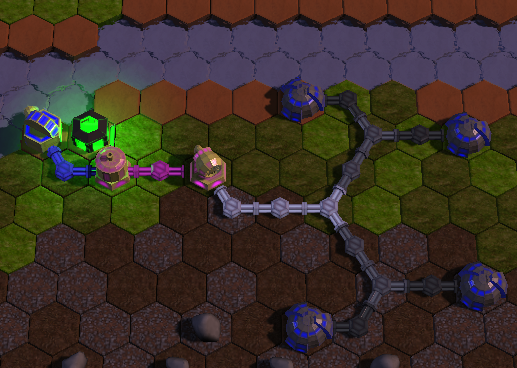
In this image, there is a Boiler producing Steam, feeding it to a Steam Turbine which produces Power and conducts it through the white pipes (Power Lines) to the 4 blue units. The power lines connecting directly to the turbine are a brighter white, indicating they are conducting more power than the branch lines, since the power flow for all 4 units flows through that main trunk. Exceeding the rated capacity of a power line results in an explosion.
Lasers
The next type of flow is Lasers. Lasers are produced by Power-consuming machinery, and can deliver power through a beam that is beamed at a laser-consuming target:
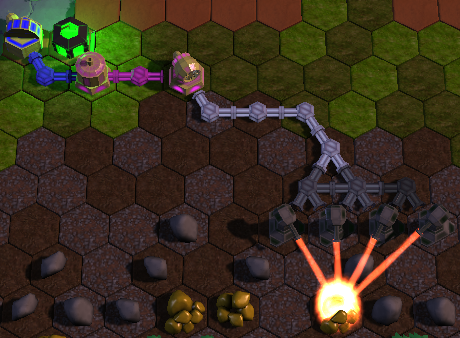
In this image, a Steam Turbine is powering 4 Drilling Lasers, which are converting Power to Laser Beams and directing those beams at a pile of gold. Laser beams can be targeted at any unit capable of consuming laser power, up to a specified radius away, by clicking on the drilling laser to advance to the next viable target. Drilling lasers are relatively short-ranged units. Later in the game, another type of laser, a Beam Tower, is available:
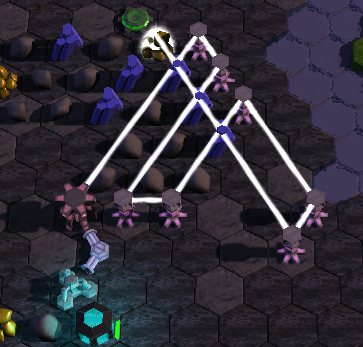
In this image, a Thermal Inductor is converting heat from a Uranium Crucible directly to Power, feeding it to a Beam Tower (pinkish unit on the left). The Beam Tower is generating a white Laser Beam, which is aimed at a blue Zandite Crystal (naturally occurring tile) which amplifies the beam. After passing through the crystal, the beam is re-directed by a series of Beam Deflector Towers, which bounce the beam around multiple times, passing it through crystals several times for more amplification, before directing it at a pile of Gold. Some maps have these Zandite Crystals for beam amplification, so wise layouts will try to use as many crystals as possible. Additionally, many laser-using units implement a Multiple Beams Bonus, amplifying the power of the beam by a small amount for each beam directed at it, so it can be wise to try to use as many individual beams as you can.
Later, beams can be split using a Beam Splitter:
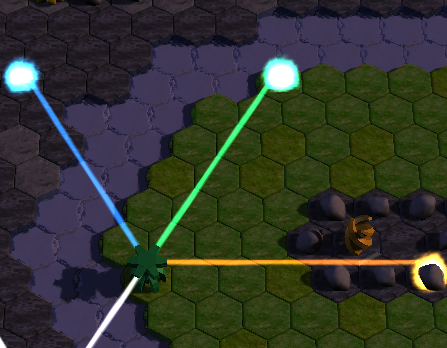
A Beam Splitter takes a white, general-purpose laser beam and specializes it, amplifying the specialized beam in the process. Red beams can be consumed by Gold-producing units to produce Gold, while green beams can be consumed by Science-producing units. (Science is a quantity used to fund technological research.) Blue beams can be consumed for utilitarian effects, as in this image:
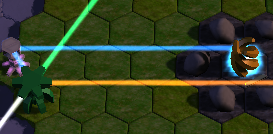
Here, a blue beam is being directed at a special, naturally-occurring tile called a Temporal Desynchronizer, to generate Extra Ticks, a quantity which can be used to speed the rate of the simulation for a certain amount of time.
Vapor
The final type of flow (so far) is Vapor. Vapor is a quantity generated by directing laser beams at a Pile of Gold. Vapor is generated proportional to the amount of laser power applied, and apportioned out to all Vapor-consuming tiles within a radius of the tile, weighted by the inverse of the distance of the consumer to the producer:
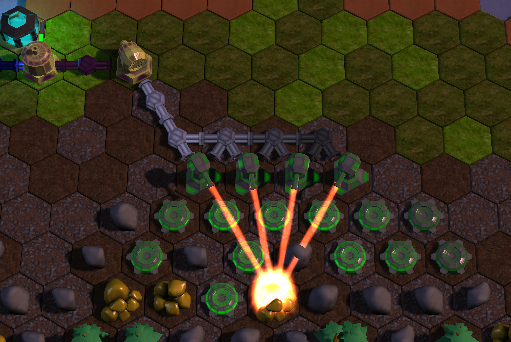
In this image, Drilling Lasers directed at a pile of Gold are producing Vapor, which is being consumed by the disk-shaped Vapor Condenser camps arrayed around it. Condensers nearer the gold mound receive proportionally more. The Vapor is generated and directly applied to each condenser unit.
As I devise additional mechanics, this list is likely to change. Thanks for reading!